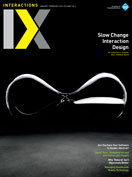Authors:
How do you describe your lab to visitors? A multifunctional spacea place where we research, design, teach, learn, play, and experiment with interaction. It is a very hands-on and active space that can be reconfigured quickly to support different activities. I like the word active, and interactivation means "making things interactive," which is a means rather than a goal. The goal is to design and develop interactive technology that enables people to do their thing, whatever that is. I am particularly interested in things that people do with technology that were not foreseen, facilitated by a flexible and interactivated design.
What is a unique feature of your lab? Its flexibility. All the furniture is on wheels so it can be moved around on the smooth concrete floor; some of it is light enough to lift. It is a mix of some top design (Euroluce, Heller Bellini, Knoll) and in-house-designed furniture. Cable trays and ducts allow all wiring (mains, network, audio, video, sensor cables) to be put in place when and where it is needed, and the trays are strong enough to support items such as projectors and speakers (or people, even). This design is based on experiences in sound studios, theaters, and labs that I set up in the past, and allows the creation of electronic ecologies.
The goal is to design and develop technology that enables people to do their thing, whatever that is.BERT BONGERS, INTERACTIVATION STUDIO
How many people are in the lab, and what is the mix of backgrounds and roles? There is no fixed crew or staff, but there is a large extended and dynamic family of "interactivists." This includes staff and postgraduate students with backgrounds in design (industrial, graphic, fashion, spatial, architecture), engineering, humanities, music, and the arts. When I have enough funding I pay people as research assistants, and we often have student interns.
Briefly describe a day in the life of your lab. There is no typical day, really. Variety is built into the design of the lab, so a day could begin in the morning with meetings and brainstorm sessions, along with hosting colleagues. In the afternoon there could be a class or group workshop of up to 20 people. A delegation of visitors to the university might also stop by to see our demos.

In the early evening there could be a presentation from a guest researcher, staff, or students who have been to a conference or won a design prize. There is time for reflection, fun, and discussion with wine and snacks.

What is one feature of your lab that you could not do without? I think it is the flexibility. As soon as things remain the same for too long it gets boring and inhibits imaginative use of the space. Incentives for change can be an event, workshop, experiment, or user test. Also, we are very visible due to a long glass wall that runs along a semi-public courtyard with the faculty café, so we treat the lab as an exhibition space with projections of interactive video. It also means, of course, that everyone can see our errors!
What is one feature of your lab you want and do not have? A goldmine! Although I think that our ideas, prototypes, products, and projects are pure gold, real gold is so much easier to sell. We actually get a lot done with relatively little money, and have been successful in attracting external funding beyond the initial support of the dean to dedicate the space and provide the budget for rebuilding and the audiovisual infrastucture. But it is never enough, and chasing big (national and competitive) funding takes up a lot of time. Research funding bodies are not naturally inclined to grasp what we do in the design field, so it is sometimes hard to convince them. Funding is needed mainly to support people and a bit of equipment.
How would you describe how people interact in your lab? We annoy each other by asking "Is it working yet?" when someone is stuck in a difficult technical problem. We stick someone's mouse to the table using Blue-Tack. Or we hide the mouse. The other day the font of my email program was set to red (while I prefer blue), and the alert sound changed to the first chord of an AC/DC song (a reference to one of my lectures). We eat dumplings together, or muffins, and discuss papers, help each other with circuits or programming, and don't hang our jackets over our chairs. We all learn from each other, and no one is right or wrong. We also have regular sessions with the students from the Master in Design Interactivation Studio program.
What is the one thing you see as most important about the work you do there? Being an interactivist! Drawing attention to the fact that you don't need to conform and comply with the way the industry delivers and imposes technology upon society, but that instead you can design and make your own, or help other people customize technology to their needs. A good design(er) facilitates rather than limits, proposes rather than imposes, guides rather than fixates, suggests rather than implies. This is what interactivation is about.
For more information on the Interactivation Studio, see: http://www.educ.dab.uts.edu.au/interactivation/
COPYRIGHT HELD BY AUTHOR
The Digital Library is published by the Association for Computing Machinery. Copyright © 2014 ACM, Inc.











Post Comment
No Comments Found